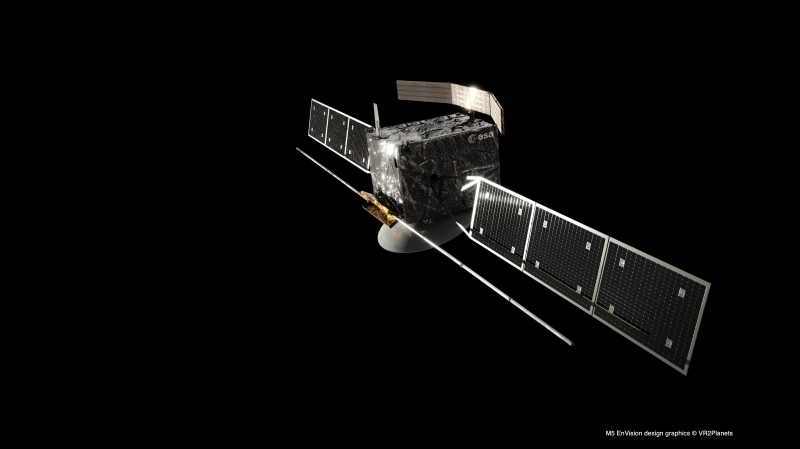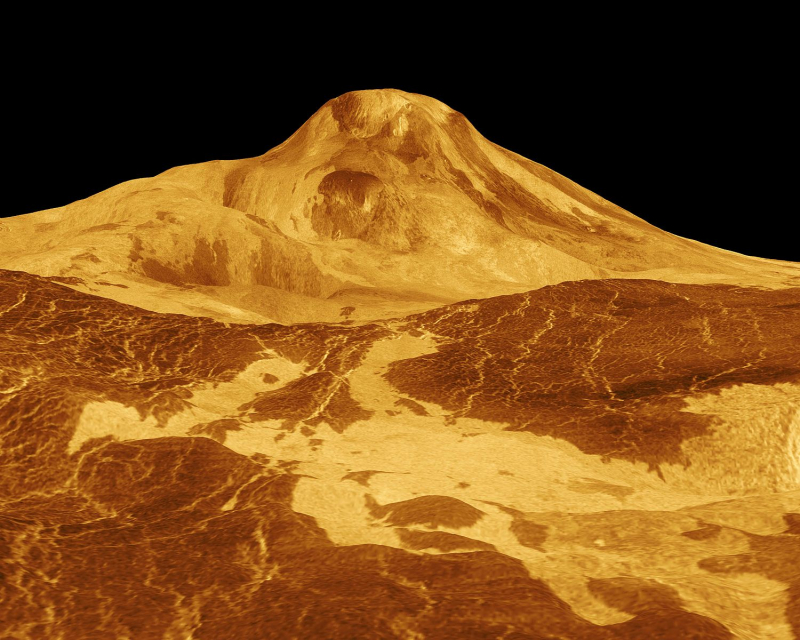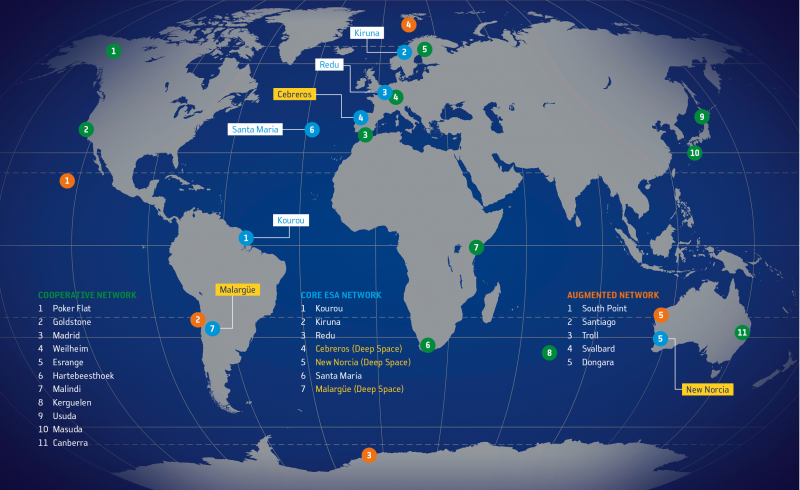Overview of the future Venusian mission EnVision
In about ten years, the European mission EnVision will set course for Venus to allow us to have, for the first time, a global vision of the planet. Indeed, we still know too little about Venus, especially in comparison with Mars, the other neighbor of the Earth. Volcanic activity, geological past, composition and dynamics of the atmosphere, composition of the core and rocks, presence of oceans in the past: scientists hope that EnVision will contribute to answer the many questions that are still pending. To do this, they are already busy preparing the mission’s key instruments: three spectrometers, two radars and a telecommunications system.
A holistic view of Venus
After several decades of near abandonment, Venus is back in the spotlight with the acceptance, in June 2021, of no less than three missions planned for 2030. Very similar in size and mass to Earth, Venus presents however infernal surface conditions: an average temperature of 470°C and a pressure 93 times higher than ours. One of the objectives of the missions to this mysterious planet is to understand why its destiny has diverged so much from that of the Earth.
As for the European probe, named EnVision, it should take off in 2032 and spend four years flying over the neighboring planet. “EnVision is a very evocative name that means: to envisage, to see through, to project and to give oneself the means to succeed,” notes Thomas Widemann, researcher at the Laboratory of Space Studies and Instrumentation in Astrophysics (LESIA) and deputy lead scientist of the mission. The trip will last 15 months and will be followed by 16 months of aerobraking, a technique that allows the probe to use the atmosphere to brake and reach the target orbit. This requires less fuel than a conventional orbit and therefore allows more of the available weight to be reserved for the onboard instruments.

EnVision was designed to provide a holistic view of Venus, from the planet’s core to its upper atmosphere,” says Emmanuel Marcq, researcher at the Laboratory of Atmospheres and Space Observations (LATMOS) and principal investigator of the VenSpec-U instrument. If it should give a global view of the planet, it will not scan the whole of Venus but an area equivalent in size to the whole of the terrestrial continents or the whole of the Martian surface. It will embark a spectrometric suite: VenSpec, two radars: VenSAR and SRS, and will carry out a radio-science experiment (RSE). “Thanks to this set of means, we will be able to better understand the interactions between the interior, the surface and the atmosphere of Venus and see the planet as a whole”, says Alice Le Gall, researcher at LATMOS and member of the EnVision science study team.
In terms of instrumental development, Emmanuel Marcq is not worried: “The technology needed to develop all the instruments already exists and, thanks to the Venusian missions of the 20th century, we know the conditions in which we will have to operate. So our goal is to take advantage of the latest technological advances to create instruments that are as powerful as possible and that can access a new field of data. In other words: to obtain scientific breakthroughs without technological breakthroughs.”
The spectrometric suite: from the ground to the upper atmosphere
The VenSpec spectrometric suite will consist of three spectrometers. VenSpec-M, developed by Germany, will map the mineralogy on the surface of the planet. The type of rocks tells us about the history of Venus,” explains Emmanuel Marcq. For example, since granites need water to form, their presence would give an argument for the past presence of liquid water on the surface.” VenSpec-H, the Belgian instrument, will study the deep atmosphere, which lies beneath the clouds. In particular, it will seek to identify trace compounds and variations in their concentrations that can provide information about potential surface activity. Indeed, the activity of a planet, such as volcanic outgassing, influences its atmosphere in time and space. Finally, VenSpec-U, developed by France, will focus on the atmosphere above the clouds in order to study the sulfur cycle, which is very present, and to understand the interactions between the lower and upper atmosphere.
Two radars and a new resolution
EnVision will also carry two radars: VenSAR, an imaging radar, and SRS, a sounder radar. VenSAR will map about 30% of the Venus surface with a spatial resolution of 30 meters. Some areas of interest will even be observed with a resolution of 10 meters! “Knowing that the last mapping, carried out by the radar of the Magellan probe between 1990 and 1994, presented resolutions between 100 and 300 meters, it will be a considerable progress”, underlines Alice Le Gall. This radar will also perform altimetry measurements, which will provide information on the surface relief, and radiometry measurements to measure the brightness temperature of the ground and thus search for possible hot spots.

As for the SRS radar, its target will be the first kilometer of crust under the surface of Venus. The waves will penetrate the ground and be sent back to the orbiter when they encounter an obstacle. This has never been done before on Venus and we don’t know what we will find,” says Alice Le Gall. There is a risk that the losses in the soil are too high and that we will not obtain conclusive results, but it is worth a try! Knowing the structure and even the stratigraphy of the subsoil will give precious information on the geological history of Venus.
A double experiment thanks to telecommunication
The last part of EnVision: the radio-science experiment. “It relies on the orbiter’s telecommunication system and does not require any additional instruments onboard,” says Caroline Dumoulin, researcher at the Nantes Laboratory of Planetology and Geodynamics (LPG) and head of the experiment. The telecommunication system allows, first of all, to receive the commands emitted from the Earth and to send the data that the probe collects to the Earth. The telecommunication antenna emits, for that, radio waves, in X band for the Earth to Venus link and in X and Ka bands for the Venus to Earth link. These bands correspond to the high radio frequencies of 8.4 and 32 GHz. The radio-science experiment has two facets: a gravity field experiment and a radio occultation experiment, both of which have been proven in the past.
The first one consists in reconstructing the gravity field of Venus from the position of the probe, which is permanently known thanks to tracking measurements. These measurements make it possible to follow the minute variations of the orbiter’s trajectory. “Indeed, any orbiter is sensitive to the local gravity field, whose perturbations influence its trajectory, explains Pascal Rosenblatt, researcher at the Nantes Laboratory of Planetology and Geodynamics (LPG) and co-leader of the radio-science experiment. The closer the orbiter is to the surface, the more accurately we can reconstruct the gravity field by tracking its trajectory.” EnVision will orbit at an altitude between 220 and 540 km, which is quite low. Gravity field anomalies are created by variations in mass distribution within the planet,” explains Caroline Dumoulin. Gravity therefore allows us to model the structure of the planet, to know if there are density anomalies such as mantle upwelling, subduction zones or crustal thickening in certain places, and to determine the size and state of the core. This information is, for the moment, very incomplete because the Magellan mission did not allow to obtain a sufficient spatial resolution on a large part of the planet. Knowing the internal structure is essential to constrain the temporal and thermal evolution models of Venus.”
The second experiment will take place just before the probe disappears behind Venus relative to Earth. At that point, radio waves pass through the Venusian atmosphere before being picked up by the ground antennas of Estrack (European space tracking, ESA’s network of satellite monitoring stations). The way in which the waves are modified (in their direction, amplitude, frequency) during this passage makes it possible to draw conclusions on the physical structure and the chemical composition of the atmosphere of Venus. “Among other things, we will be able to measure the abundance of gaseous sulfuric acid thanks to the X-band waves and liquid in the clouds thanks to the addition of the Ka band. This is the first time that this will be done for liquids,” enthuses Caroline Dumoulin. The interest of this double measurement is to better understand the cycle of sulfur dioxide, which could be a signature of the volcanic activity of the planet.

The team is currently investigating the possibility of adding an ultra-stable clock to improve the coverage of the radio occultation experiment. “There is a mass reserve on the probe that allows for some adjustments during the mission design phase,” explains Caroline Dumoulin. We will know in a few months if adding this clock is possible.” To be continued.
EnVision: An important French contribution
Several French laboratories will be involved in EnVision: IRAP, LATMOS, LESIA, LMD, LPG.
- LATMOS (Emmanuel Marcq) is responsible for the supply of the UV spectrometer VenSpec-U.
- The LPG (Caroline Dumoulin and Pascal Rosenblatt) has the scientific responsibility of the radio-science experiment.
- LESIA (Thomas Widemann) will provide the telescope of the VenSpec-M mineralogical imager.






